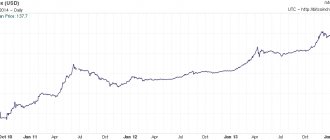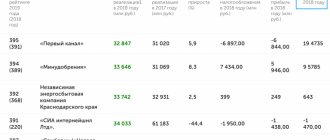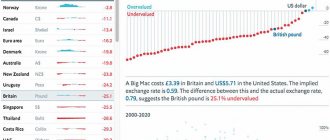2021-12-28 66920
KFO No. 10 2014 Lesnova Yu.V., Director of LLC AF "Audit and Consulting Center"
The article was provided by the editors of the journal “Corporate Financial Reporting. International Standards" within the framework of the joint project "IFRS Methodology for Companies and Experts" of the Publishing House "Methodology" and the Financial Academy "Asset" for experts in the field of IFRS.
The entire IFRS methodology, expert comments, practical developments, and industry recommendations are available with an annual and semi-annual subscription to the magazine.
The time value of money is one of the basic principles for recording business financing transactions. The time value of money relates to interest rates, compound interest, the concept of time, and the risks of cash and cash flows. Any company is an investment object, that is, by attracting funds from investors today, the company must, over time, ensure the return of debt to the investor (creditor, shareholder) and pay remuneration for these investments.
The concept of the time value of money is based on the following: the value of one monetary unit that is available at the present time is greater than the value of one monetary unit that will be available in the future. This happens for three reasons. First, the currency can be invested now, in which case interest will be earned for the duration of the investment. Secondly, money is subject to inflation, that is, its purchasing power decreases over time, which makes the value of money less in the future, since today you can buy more with this money than with the same money in the future. Thirdly, there is always a risk of not getting the invested money back in the future, but if you have money at the moment, then there is no risk that this will happen.
The concept of time value allows the investor to take the above reasons into account when making financial decisions by estimating cash flows over different periods of time, based on the conversion of cash flows to the current moment or to a future point in time.
Discounting Basics
The time value of money includes the concepts of future value (compounding) and present value (discounting).
There are four main types of time value of money used in the calculations:
- future value of a lump sum payment,
- future value of the annuity,
- present value of a one-time payment,
- present value of the annuity.
Financial accounting uses discounted cash flows to ensure comparability of financial statements of different companies and different reporting periods. In addition, discounting allows you to clearly determine financial expenses for the reporting period, taking into account the specific financing features of a particular company.
In general, discounting operations come down to the discounting formula:
PV = FV / (1 + i)n,
where PV is the current value; FV - future value; i is the discount rate; n—term (number of periods).
In order to determine the future value, you should transform the formula:
FV = PV × (1 + i)n,
Example 2
The company wants to have 1 million rubles. after 3 years, subject to an interest rate of 10% per annum. The amount that needs to be invested at the moment will be:
PV = FV / (1 + i)n = 1,000,000 / 1.331 = 751,315 rub.
In IFRS, discounting is covered in several standards, but IFRS 13 Fair Value Measurement and IAS 36 Impairment of Assets cover them in particular detail.
Discounting in IFRS 13
IFRS 13 Fair Value Measurement provides methods for measuring fair value that involve discounting when the income approach is used in determining fair value. When using the income approach, future amounts (such as cash flows or income and expenses) are converted to a single current amount (ie, discounted value) when estimating fair value. And the result of the fair value measurement reflects current market expectations regarding such future amounts. The present value method used to determine fair value will depend on the facts and circumstances specific to the asset or liability being valued (for example, whether prices for comparable assets or liabilities are observable in the market) and the availability of sufficient data. It can be argued that when using this method, observable data (for example, the risk-free rate on capital) can be used.
Formula of life: time + money
You can also turn to an example familiar to almost every person. We have some spare money that we can spend. But in order to increase our finances , we go to the bank to open an interest-bearing account there.
If you deposit 20,000 rubles. at 10% per annum, then after a calendar year, you will already have 22,000 rubles in your account.
In the formula this is calculated as: 20000*(1+10%).
The calculation for increasing (building up) the account , let’s take it over three years , will be slightly different: (20000*1.10)*1.10)*1.10= 26,620
And it looks like:
(1+R) N, where
R – interest rate in decimal,
N is the billing period.
For information
According to paragraph B13 of IFRS 13, present value (that is, applying the income approach) is a tool used to relate future amounts (for example, cash flows or values) to a present amount using a discount rate.
The determination of fair value at present value is based on the assumption that a potential investor (buyer) will not pay more than the present value of future cash flows; in turn, the seller will not sell at a price that is lower than the present value of projected future earnings. As a result of this equilibrium, the parties will agree on a market price equal to the present value of future income.
In essence, the present value of cash flow approach appears to be a more appropriate valuation method when current performance can provide some indication of what it will become in the future, including assumptions about future growth rates.
Determining the fair value of an asset or liability using the present value method covers all of the following elements from the perspective of market participants at the measurement date:
- an estimate of future cash flows from the asset or liability being measured;
- expectations regarding possible changes in the amount and timing of cash flows representing the uncertainty inherent in cash flows;
- the time value of money, represented by the rate on risk-free monetary assets that have maturities or expiration dates that coincide with the period covered by the cash flows and that do not present any uncertainty about the timing and risk of default to their holder (that is, the risk-free interest rate);
- the price paid for accepting the uncertainty inherent in cash flows (that is, the risk premium); other factors that market participants would take into account in the circumstances;
- the risk of default associated with a given obligation, including the entity's (that is, the person accepting the obligation) own credit risk.
The general principles for applying any present value valuation method are as follows:
- Cash flows and discount rates should reflect the assumptions that market participants would use when pricing the asset or liability.
- For cash flows and discount rates, only those factors that are relevant to the asset or liability being valued should be considered.
- To avoid double counting or missing the impact of risk factors, discount rates should reflect assumptions consistent with those inherent in the cash flows.
- Assumptions regarding cash flows and discount rates must be consistent with each other. For example, nominal cash flows that include the effect of inflation must be discounted at a rate that includes the effect of inflation. The nominal risk-free interest rate includes the effect of inflation. Actual cash flows that exclude the effect of inflation must be discounted at a rate that excludes the effect of inflation. Similarly, net-of-tax cash flows should be discounted using the net-of-tax discount rate. Pre-tax cash flows should be discounted at a rate consistent with the stated cash flows.
- Discount rates should take into account the underlying economic factors associated with the currency in which the cash flows are denominated.
How to calculate indicators for present value in Excel
The traditional lifesaver for accountants in cases where discounting needs to be done is Excel. It has functions both for calculating, for example, the discount rate for the lessor, and for calculating the amounts themselves.
NETIR function
Using this tool, you can calculate the internal rate of return for the lessor (lessor).
To use this tool, you need to enter data on the dates and payments of the contract into an Excel sheet. And in the first line reflect the amount of investment with a “-” sign.
Let's take the data from the example about renting out Kostya's cafe. Let him transfer the cafe to the tenant on 01/01/2022, and the tenant pays after a year. For simplicity, we will not take into account non-guaranteed liquidation value.
Next, place the cursor in a free cell and click on the formula icon. The NET INDOH formula is located in the Financial section. In English Excel it is also called XIRR.
We enter the data for the calculation, highlighting the necessary areas. We put total values first, dates second.
Next, click OK and get the discount rate, with which the lessor needs to make calculations to reflect agreements in the reporting according to FAS 25/2018.
Important!
All payments under the terms of the contract must be rewritten by date. If, for example, you have a contract for 5 years with monthly payments, you will have to fill out 60 lines for each payment.
But parameters such as frequency and annuity do not affect the accuracy of calculations. Using the formula, you can calculate the internal rate of return both if payments are made arbitrarily and if their amounts are not equal.
PURE function
Using this formula, knowing the discount rate, you can quickly calculate the net value of the rental investment at the reporting date. The English abbreviation for the function is XNPV. This formula is also more suitable for the lessor (lessor).
For calculations, you can create another column in the table, which is made up of payments and their dates.
At the time of transfer, the value of the investment is assumed to be equal to the fair value of the investment in the rental or leasing object. Let's say in secret that if an asset leased out was accounted for in compliance with the rules for admission to the balance sheet, valuation and testing for impairment, then its value upon transfer can be considered fair.
And then we begin to calculate the net investment value for each last day of the year.
Important! If the date on which the present net value of the investment is determined is also the date of payment under the contract, then the payment amount must be subtracted from the value obtained using the NETNZ formula.
We select values starting from the date on which we are counting and further until the end of the contract. We choose the dates accordingly.
We subtract the amount of payment under the contract from the value obtained by the formula to obtain a fair value at the end of the day on December 31.
When the next date arrives, we do the same. It is recommended to save the calculations for each contract.
Further calculations for the landlord
Using the obtained values, the lessor can determine the amount of interest income to be reflected in accounting according to the rules of FAS 25/2018.
And the resulting calculation plate in its entirety, just in case.
Lessee's present value
The functionality described below is more suitable for tenants. For example, to calculate the present value of payments under a contract.
In principle, having determined the discount rate, using Excel you can make calculations simply through formulas. Let us remind you that the power icon in an Excel formula is set as the combination “^number”, for example, to raise to the 3rd power you need to enter “^3” into the formula.
For example, let’s show what the present value will be for payments under the contract from the tenant of Kostya Cafe. Let’s say that to buy everything he rents from Kostya, he would need to take out a bank loan at a rate of 11.5% per annum.
We remember that in this case each payment is discounted. And t takes the value of the number of periods remaining until payment.
If t is expressed not in years, but in smaller periods: quarters or months, then to substitute it into the discounting formula, you need to calculate the rate corresponding to the period based on the annual rate.
r = ((1 + annual rate/100)1/number of periods in a year X 100%
For example, with quarterly payments the power will be 1/4
r = ((1 + annual rate/100)1/4 X 100%
You can also use the PS function (present value, in English PV). Remember that it only works correctly for a single interest rate and a fixed periodic payment amount.
Let's try to calculate the present value of payments under the contract using the PS function
Rate – indicate the rate value for the payment period. For example, for a quarterly quarter, calculating it using the formula proposed above.
Nper – the number of periods for which payments will be made until the end of the contract. We calculate for all payments, so we set it to 4.
PMT – fixed payment amount for a period. If we are counting income (for example, from investments), we put the value with a plus. If we count payments, we put them with a minus.
Fs – future value. The desired balance after completing payments. In this case it is not needed. If the cell is not filled, the program automatically counts 0.
Type – payment characteristics: at the beginning of the period – 1, at the end of the period – 0. If not filled in, 0 is automatically considered (end of the period). We are just at the end of the period, so we are not filling it out.
When everything is entered, click OK.
As you can see, the total amount of discounted payments calculated by period and the amount obtained using the PS function are the same.
NPV is another similar function. It is convenient in that you can select any payment amount from those already entered into the table.
The result obtained will coincide with that obtained from the PS and from the addition of the discounted amounts of each payment.
Example 3
Company A measures the fair value of assets at present value. For the calculation, the company has data on the real return on assets in the amount of 10% per annum. The expected inflation rate is 5% per year, so the company reports cash flows taking into account the inflation rate. To determine the present value of cash flows, a company must use a nominal interest rate to discount. To do this, you can apply the Fisher formula:
1 + Nominal interest rate = = (1 + Real interest rate) × (1 + Inflation percentage).
Thus, company A will discount cash flows at a nominal rate:
[(1 + 0,1) × (1 + 0,05)] − 1 = 15,5 %.
Example 4
Company A calculates the fair value of the equipment. The after-tax cost of capital at par is 10%. Let's say inflation is 3% per year. The following information is available on cash flows at par:
Thus, the fair value of the asset is RUB 30,192 thousand.
Let's consider discounting cash flows at real value.
(1 + Real interest rate) = (1 + Nominal interest rate) / (1 + Inflation rate) = (1 + 0.1) / (1 + 0.03) = 6.8%
In this case, the fair value of the asset will be RUB 30,194 thousand.
Thus, fair value determined by discounting at par and discounted at fair value have the same result.
Where does profit come from in the stock market?
Investing in stocks is investing in a business. Buying his share. What is the main goal of the business? Receiving a profit.
Profit on the stock market is reflected in changes in the company's capitalization (increase in stock prices). Plus dividends paid.
Profit = price growth + dividends
A stable operating business generates added value (in the form of profit) and allows all shareholders to earn money. Well, almost everyone.
Example.
Let’s say the capitalization of a company increased by 30% over a certain period. Quotes for one share increased from 100 to 130 rubles.
Would it be correct to assume that each shareholder received 30% of the profit? No.
Someone could buy shares at 80, 120 or even 140. Accordingly, someone sold them shares at these prices.
As a result, some received more than 30%, others less. Some may even have gone negative. But on average, all shareholders of the company earned 30% of the profit.
Example 5
As of January 1, 2014, the company has an obligation to decommission equipment at the end of its useful life, which is estimated at 10 years. The Company assessed the costs of fulfilling the obligation and determined other conditions associated with its fulfillment:
- The expected outflow of funds for the work performed by the contractor is 1,500 thousand rubles. The contractor typically seeks compensation for the risk that actual cash outflows may differ from those estimated due to the uncertainty inherent in the 10-year completion date. According to the company's estimates, the amount of such compensation is 10%, taking into account inflation.
- The expected outflow to pay for the company's overhead costs is 1000 thousand rubles.
- The expected inflation rate is 4% per year.
- The risk-free rate as of January 1, 2014 for a period of 10 years is 5%. The company adjusts this figure by 3.5% taking into account the risk of non-compliance. Therefore, the risk-adjusted discount rate is 8.5%.
The fair value of the liability will be calculated using discounted cash flows as follows:
Thus, the fair value of the liability is RUB 1,800.33 thousand.
Discounted Cash Flow Method
With the discounted cash flow method, investors estimate future expected cash flows and discount them at a rate of return that takes into account the time value of money and the relative risks of the investment. The discounted cash flow method can be represented by the following formula:
DCF = CF1 / (1 + k) + CF2 / (1 + k)2 + CFn / (1 + k)n,
where DCF is discounted cash flow; CF1, CF2, CFn - cash flows by period; k is the discount rate.
A company's free cash flow is the cash flow from an asset before any debt payments are made. Operating cash flows do not take into account interest and its impact on taxes, since this factor is directly included in the discount factor.
When assessing future expected cash flows, the following types of risks are usually distinguished:
- single risk;
- market risk.
Unit risk represents the uncertainties inherent in expected cash flows.
How to increase (not decrease) profits?
Can an investor personally influence the final financial result? And increase profitability.
Can! You need to increase the value in the numerator. And reduce the denominator.
The investor will not be able to influence the growth of the stock market (and dividends).
Alternatively, try to guess potentially more profitable companies. Which will bring in more money than the stock market as a whole. Or look for entry points (market timing) into the market at optimal prices.
But here you can both earn and lose. Or not even getting an average result. Plus, this requires certain knowledge, experience and a huge amount of additional time. No guarantee of improved results. In short, this option is not for everyone.
All that remains is to reduce costs and the cache share. Here everything is in the hands of the investor. All correct actions will give a guaranteed result. And they will automatically lead to an increase in profitability.
What can be done?
- Choose a broker with minimal commissions.
- Minimize the frequency of transactions (capital turnover).
- Think about optimizing taxation (use benefits under IIS and DVL).
- Choose funds with minimal management fees (all other things being equal).
Related articles:
5 life hacks on how to reduce income taxes;
Tariff traps of brokerage accounts;
Review of tariffs - choose a profitable broker.
Risk assessment method
The risk assessment method is the use of statistical probability method. The expected present value method uses a set of cash flows that represents a probability-weighted average of all possible future cash flows. The resulting estimated value is identical to the expected value, which in statistical terms is the weighted average of the possible value of a discrete random variable with its corresponding weighted probability. Because all possible cash flows are weighted by probability, the resulting expected cash flow is not conditional and does not depend on the occurrence of any specific event.
Example 6
Company A calculates the fair value of the equipment. The company's cost of capital is 10%. The following information is available about the probability distribution of cash flows:
Let's calculate the discounted value of cash flows.
In this case, the fair value of the asset will be RUB 24,693 thousand.
It should be noted that in practice there may be many possible outcomes. However, in order to apply the expected present value method, it is not always necessary to consider the distribution of all possible cash flows using complex models and methods. Instead, a limited number of discrete scenarios and probabilities can be developed that cover a variety of possible cash flows.
Margin of safety
The margin of safety is the excess of the profit received over the break-even point. If we return to our first example, the break-even point is reached in the 8th year after purchasing the property. Next, the net present value takes a positive value.
The margin of safety can be expressed in different units:
- number of units of goods or products;
- in monetary terms;
- in percentage terms.
Let us remind you that the amount of initial investment is RUB 4,687,500. ($62,500 or 1,812,500 UAH).
If we sum up the DCF values for years 1 to 7, we get:
4464.29+5580.36+6975.45+8719.31+9196.85+13623.92+17029.90=4,919,255 rub. ($65,590.07 or 1,902,112 UAH).
By the end of the 8th year, the sum of the DCF values will be: 65590.07 + 21287.37 = 86877.44.
Margin of safety (MOS) will be: 86877.44-62500= RUB 1,828,308. ($24,377.44 or 706,946 UAH) .
As you can see, the margin of safety indicator is equal to the NPV value.










